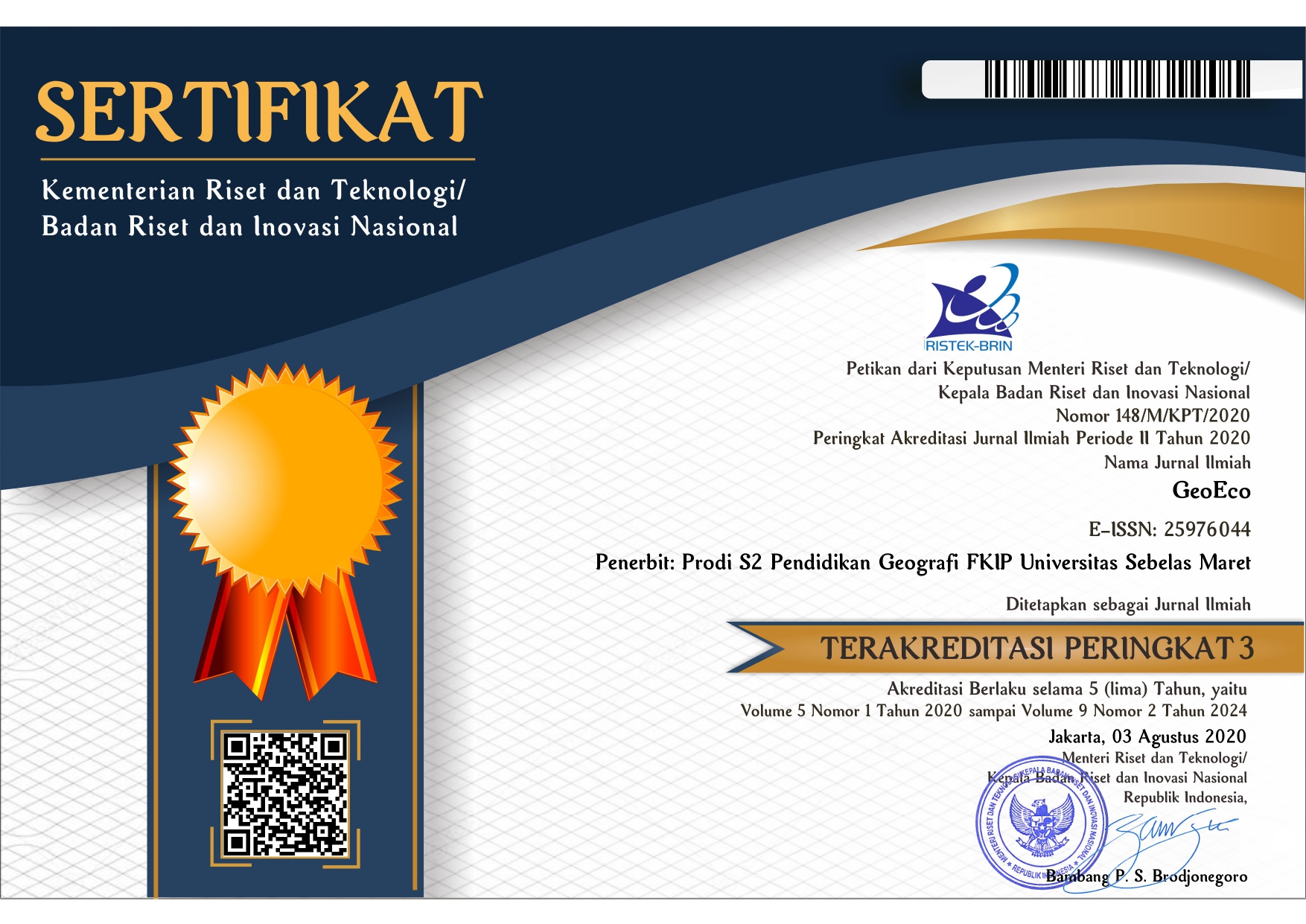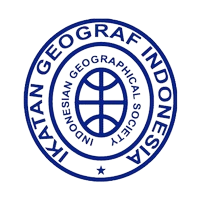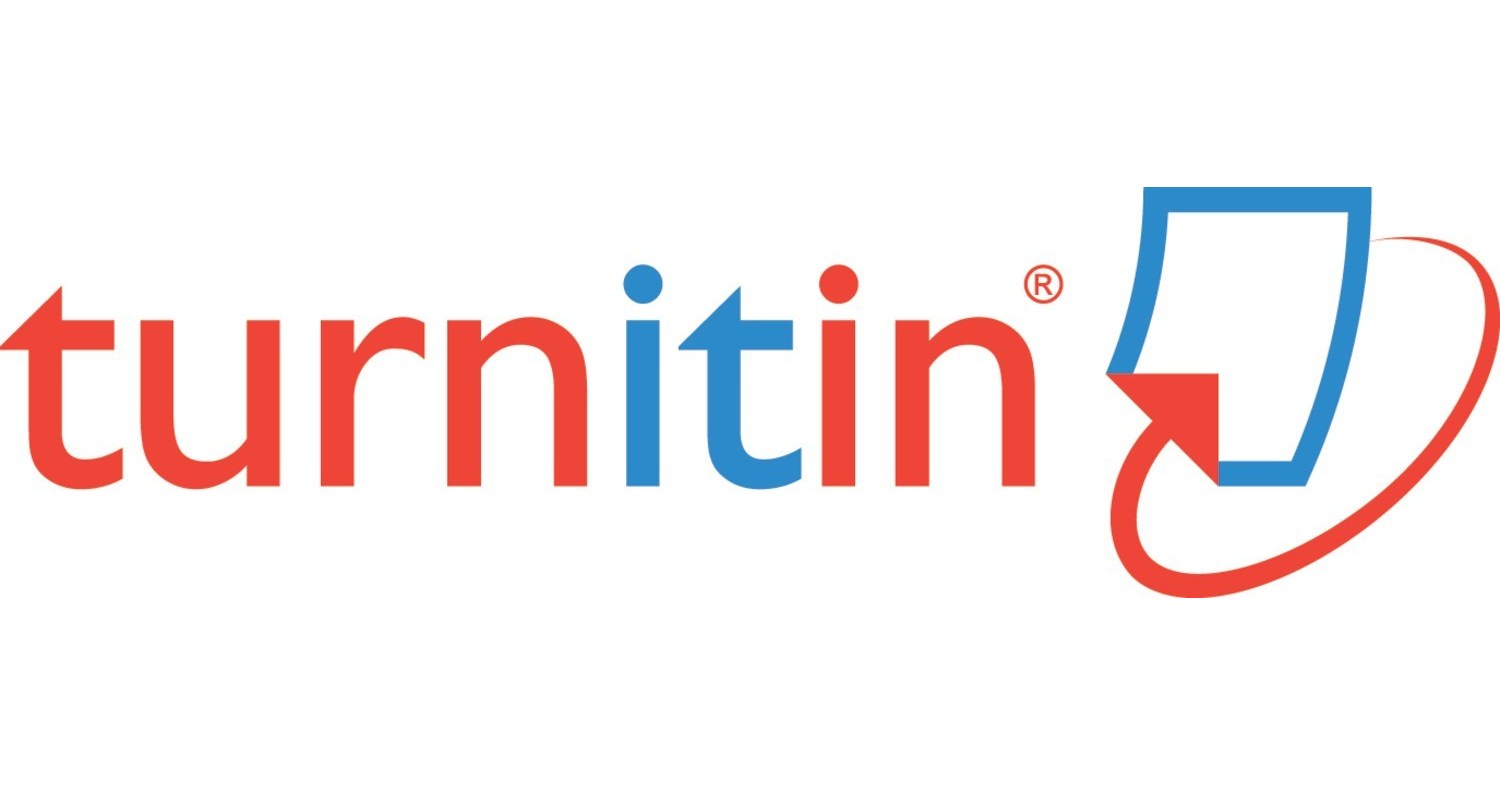IDENTIFICATION OF KAMPUNG NAGA CULTURAL POTENTIAL IN SUPPORTING THE REALIZATION OF GEOPARK GALUNGGUNG
Abstract
Geopark Galunggung is a platform that accommodates geodiversity,biodiversity and cultural diversity in Tasikmalaya Regency.Kampung Naga is part of the Geopark Galunggung development area.The method used in this study is a qualitative descriptive method.Data collection techniques by observation, interviews, documentation studies and literature studies.The purpose of this study is to identify and inventory the cultural potential that exists in the Geopark Galunggung area so as to produce a dossier manuscript of the Geopark Galunggung.The results of the study classify cultural potential into two, namely tangible potential including (1) Cultural heritage objects including Sanusantara heirlooms; (2) Cultural heritage buildings include Kampung Naga Traditional House, Bumi Ageung, Bale Patemon,Assalam Mosque,Kujang Heritage Monument,Saung lisung,rice barn; (3) There is no cultural heritage structure at the research site; (4) Cultural heritage sites include the Pangsolatan site and the Lumbung site; (5) The cultural conservation area covers the entire area kampung Naga. As well as intangible potential consisting of (1) Traditions and Oral Expressions; (2) Performing arts such as terebang gembrung,terebang sajak,angklung buhun; (3) Customs include traditional ceremonies, marak, hajat karya; (4 )Community knowledge includes community farming systems, availability of homestays, Tour Guides Association,Community UMKM; (5) Proficiency in traditional woven bamboo crafts. These tangible and intangible potentials still exist today because they are preserved and passed on to the next generation.
Keywords
Full Text:
PDFReferences
Bachri, S Bachtiar. 2010. “Meyakinkan Validitas Data Melalui Triangulasi Pada Penelitian Kualitatif.” Jurnal Teknologi Pendidikan 10 (1).
Darmawan, Cahya, Siti Fadjarajani, and Iman Hilman. 2021. “CULTURAL DIVERSITY OF LOCAL COMMUNITIES TO CREATE GALUNGGUNG GEOPARK IN TASIKMALAYA REGENCY.” Spatial : Wahana Komunikasi Dan Informasi Geografi 21 (1).
Fahrudi, Erista Zulki ;, and Dheny Wiratmoko. 2018. “Masyarakat Geopark Gunung Sewu Pacitan Dalam Perspektif Ekonomi, Tradisi Dan Budaya.” JURNAL AGASTYA 08 (01).
Faisal, Mohammad, Moh Gamal Rindarjono, and Chatarina Muryani. 2016. “ANALISIS LUBUK LARANGAN SEBAGAI WISATA EKOLOGI BERBASISKAN KEARIFAN LOKAL DESA LUBUK BERINGIN, KECAMATAN BATHIN III ULU, BUNGO, JAMBI (Sebagai Pendukung Substansi Materi Pengelolaan Sumber Daya Alam Pada Bidang Studi Geografi Di Kelas XI SMA).” Jurnal GeoEco 2 (2): 103–13.
Goeldner, C, Harles R., and J. R. Brent Ritchie. 2012. Tourism: Principles, Practices, Philosophies. New Jersey: John Wiley & Sons, Inc.
Gubernur Jawa Barat. 2018. “PERGUB Nomor 72 Tahun 2018 Tentang Pengembangan Kawasan Geopark Di Daerah Provinsi Jawa Barat.”
Illiyani, Maulida. 2018. “BERFIKIR INTELEKTUAL, BERWAWASAN GLOBAL, DAN TETAP MELANGKAH LOKAL”: PROSPEK KAMPUNG NAGA MENJADI DESA ADAT.” Masyarakat & Budaya 20 (1).
Kamardi, Agus Dono. 2007. “Budaya Lokal Sebagai Warisan Budaya Dan Upaya Pelestariannya.” Jawa Tengah.
Kusumahbrata, Yunus. 2020. “Pengembangan Aspiring Geopark Galunggung Tasikmalaya.” Jakarta.
Nurhanifa, Eka Rahma;, Neneng; Konety, and Raden Muhammad Teguh Nurhasan Affandi. 2020. “Diplomasi Publik Baru Indonesia Terhadap UNESCO Dalam Menjadikan Kawasan Geopark RinjaniLombok Sebagai Geopark Global UNESCO.” Padjadjaran Journal of International Relations (PADJIR) 1 (3). https://doi.org/10.24198/padjir.v1i3.26195.
Pemerintah Desa Neglasari. 2020. “Data Sensus Penduduk Desa Neglasari Tahun 2020.” Tasikamalya.
Stoffelen, Arie, Pete Grootea, Erik Meijlesa, and Gerd Weitkampa. 2019. . “. Geoparks and Territorial Identity: A Study of the Spatial Affinity Ofinhabitants with UNESCO Geopark De Hondsrug, The Netherlands.” Elsevier Applied Geography 106. https://doi.org/https://doi.org/10.1016/j.apgeog.2019.03.004.
Sukmadinata, Nana. 2015. Metode Penelitian Pendidikan. Bandung: Rosda Karya.
Taylor, K. 2013. “Cultural Mapping: Intangible Values and Engaging with Communities with Some Reference to Asia.” The Historic Environment 4 (1): 50–61.
Timang, Vica Vanessa Sesaryo, Antariksa, and Ismu Rini Dwi Ari. 2016. “Pelestarian Dukun Buntula’bi Balusu Sebagai Warisan Budaya Di Kabupaten Toraja Utara.” Jurnal Penataan Ruang 11 (1).
Undang- Undang Republik Indonesia Nomor 11 Tahun 2010 tentang Cagar Budaya. 2010. “Undang- Undang Republik Indonesia.” Jakarta.
UNESCO. 2003. “The Convention for the Safeguarding of the Intangible Cultural Heritage.” Paris.
Refbacks
- There are currently no refbacks.












.png)

